Affiliate disclosure: This post may contain affiliate links. Please see our Privacy Policy.
Simple homemade lemon wine is like sipping summertime!
This simple recipe only requires a few ingredients, and if you harvest lemons in season during winter the finished lemon wine will be ready just in time for summer.

Citrus, especially lemon, finds its way into all manner of wine recipes. My homemade dandelion wine recipe has quite a bit of citrus added, meaning that it’s really more or less a citrus wine flavored with the floral aromatics of dandelion petals. Why not try skipping all that, and just make a pure, sweet and refreshing lemon wine?
How to Make Lemon Wine
Since this recipe includes whole lemons, both juice, and peel, I’d strongly suggest starting with organic lemons. A full gallon of lemon wine only requires about 8 to 10 lemons, and even at the fancy natural food store that only set me back about $7.
Not bad, given that the other ingredients are pretty inexpensive. In total, this homemade lemon wine will cost around $2.50 per bottle even with purchasing organic lemons. If you’ve got free backyard lemons, even better.
Start by slicing the lemons thin and placing them in a large saucepan with the sugar.

Add in either 1 lb of golden sultana raisins or about a quart of white grape juice. The yeasts need something to nourish them, and lemons aren’t exactly full of the correct nutrients to get the job done.
You need a sweet fruit to provide micronutrients for the little beasties, and raisins or grape juice are perfect. For this recipe, I suggest golden raisins or white grape juice so that it has less of an impact on the color of the finished wine.
Beyond the grape juice or raisins, the yeasts also need a little bit of yeast nutrient to carry them through to complete fermentation. Roughly 1 teaspoon of powdered yeast nutrient does the job nicely. I’ve also included 1 tsp of pectic enzyme to help the wine clear, but that’s optional and merely cosmetic.

I generally use premier blanc wine yeast in my homemade wines, and that’s a good choice for this lemon wine. Please, whatever you do, don’t add bread yeast. Yeast actually imparts quite a bit of flavor to wine, and bread yeast wines taste…well, like bread.
Just don’t do it. It’s only about $1 for a packet of yeast, and it’s well worth the investment. If you’re making more than one batch at a time, a single packet is enough for 5 gallons of wine (dissolved in water and then distributed evenly among the carboys).
I’m using a one-gallon wide-mouth fermenter for this batch because I want to leave the whole lemon slices in for the primary ferment. If you’re using a standard narrow neck carboy, filter them out before putting everything into a carboy or you’ll clog up the neck. In that case, juice and zest the lemons instead of slicing them, and discard the rinds.
You can also divide this recipe in half and make a half-gallon of lemon wine in a half-gallon mason jar with a silicone airlock kit. This recipe works fine with Meyer lemons as well, and the flavor of a Meyer lemon wine is a bit less acidic and slightly warmer to the palate.
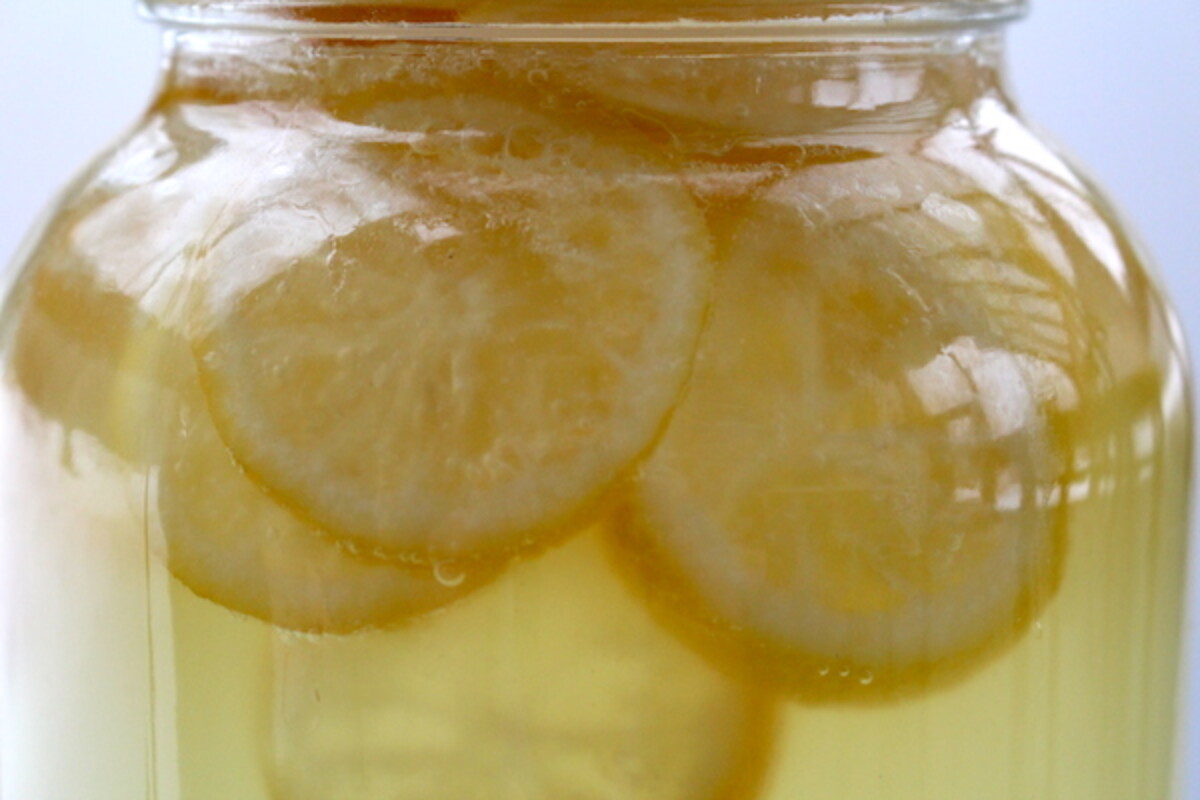
Lemon Mead Recipe Variation
Since lemons aren’t exactly high in sugar, this recipe requires about 3 pounds of added sugar to allow the mixture to ferment. If you’d like to try a lemon mead instead, the recipe is the same…simply substitute 3 lbs of honey in place of the white sugar.
Keep in mind, honey is quite a bit less fermentable than white sugar and the wine will take a bit longer to brew. Mead also benefits from more time aging in the bottle, and I’d suggest bottle conditioning a lemon mead for at least 6 months (as opposed to 3 for a lemon wine).
A lemon mead would be pretty similar to this rhubarb mead, and you could actually just substitute lemons for rhubarb in the recipe. This particular recipe is a micro-batch mead recipe, which makes just one quart of mead. That might not be a bad idea if you’re trying something experimental.
Similarly, if you want to make just a single quart to see if lemon wine is really your thing, this recipe can be divided by 4 for a quart batch using this small-batch wine method.
I also came across a recipe for a traditional Finnish drink called Sima. It’s a carbonated lemon soda that’s naturally carbonated by letting it ferment with a tiny pinch of yeast for just a few days. They drink it to celebrate new years, which happens in late April in their traditional calendar.
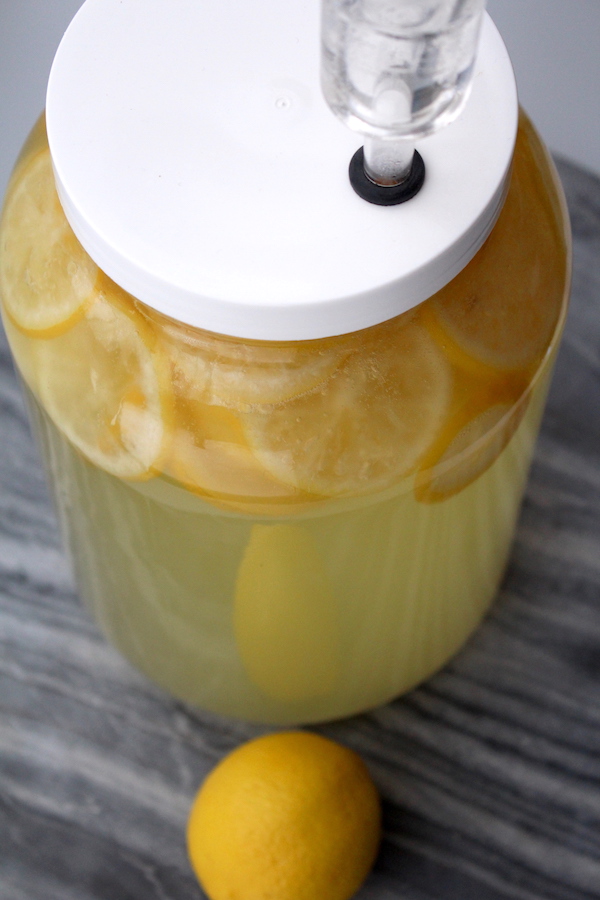
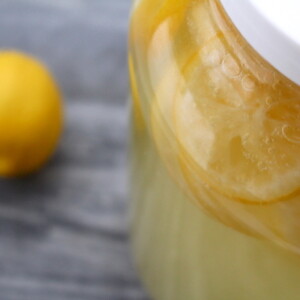
Lemon Wine
Ingredients
- 8-10 lemons, thinly sliced
- 3 lbs sugar
- 1 lb sultana raisins, or 1-quart white grape juice
- 1 tsp yeast nutrient
- 1 tsp Pectic Enzyme
- 1 wine yeast, dissolved in 1/4 cup water
- water to fill
Instructions
- In a large saucepan, bring water, lemons, sugar and raisins (or grape juice) to a boil. Turn off the heat and stir to dissolve the sugar. (If using a narrow neck fermenter, juice the zest the lemons instead of slicing, discarding the rind).
- Allow the mixture to cool before pouring everything (lemons included) into a primary fermentation vessel.
- Add the yeast nutrient, pectic enzyme and wine yeast. Stir to incorporate, and allow the mixture to ferment for 7 to 10 days.
- After primary fermentation, rack the wine into a secondary fermenter using a sterilized siphon. Ferment for about 6 – 8 weeks in secondary, until fermentation stops and the wine clears.
- Bottle the lemon wine in corked wine bottles, and allow the mixture to age for at least 3 months before drinking.
Notes
Nutrition
Nutrition information is automatically calculated, so should only be used as an approximation.
More Homemade Wine Recipes
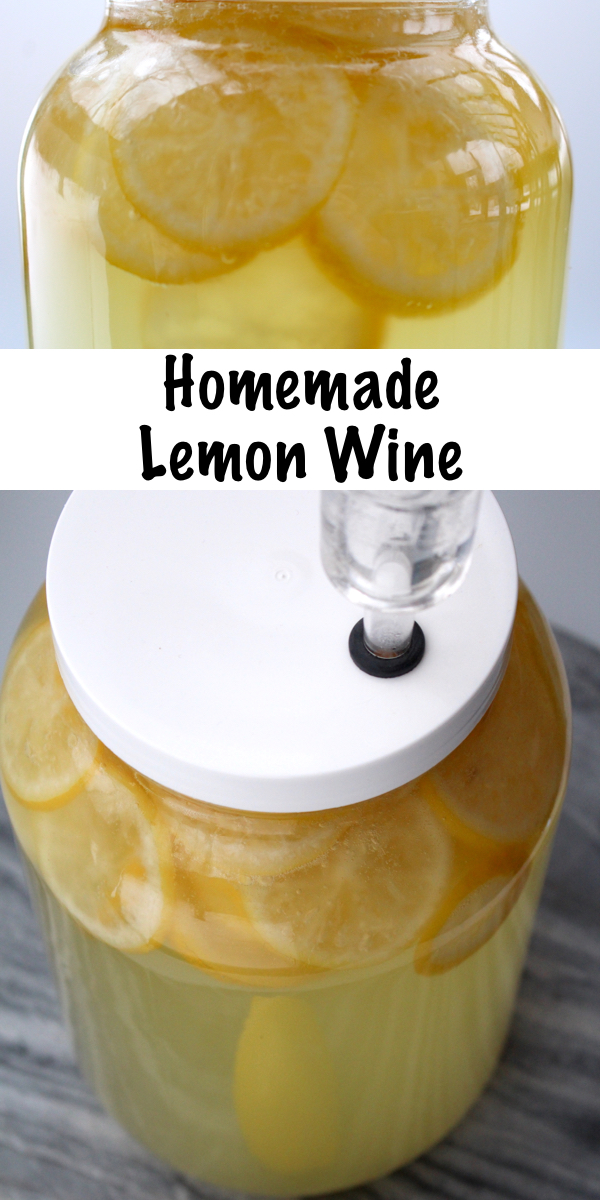



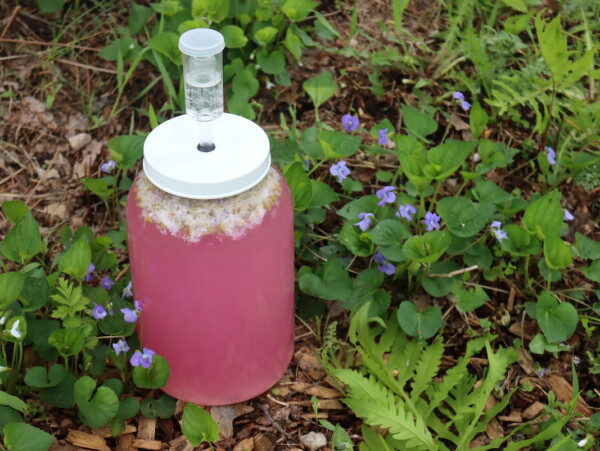










Hi, do I strain this before secondary fermentation?
Yes, strain out all the solids when you rack it into secondary.
Hi Ashley, I’m still using your Lemon Wine Recipe. Discovered it works on Satsumas but you loose quite a bit of the Satsuma taste till…………..I blended the finished wines. Now I make both to your recipe but blend them when stabilizing and back sweetening just a little. The Satsuma needs it. Music is made when the 2 are blended 50/50. My Meyer Lemon tree and Owari Satsuma trees are loaded again this year. I wish you could see the expressions on peoples faces when I bring this wine to Crab & Crawfish Boils. It just astounds them how good they taste together. Keep Posting.
Awesome! So glad it turned out for you.
I am new to this and need some help. I put all of the lemon wine ingredients in a gallon bottle for the primary fermentation with the airlock. It went crazy with bubbles for 4-5 days. I think I’ve messed it up and should have used the airlock in the secondary fermentation which I haven’t done yet. Have I messed this batch up. I noticed a comment about bubbles coming up through the airlock and I didn’t notice any bubbles in the airlock on my bottle.
What did you end up doing with your wine?
I filtered it into a different container, cleaned out the airlock container and put the wine back into it. It’s in the cabinet fermenting I hope.
Great job! That’s exactly what I would have done. Let us know how it turns out.
Fermentation
Do you make lime wine the same way, but exchanging lemons for limes? The link to your lime wine recipe isn’t working for me …
We don’t have a lime wine recipe on our blog. The link that you’re referring to is actually to another website. You can just use this recipe and swap out the lemons for limes.
Hi Ashley, just following up on your Lemon Wine Recipe. I have learned that 3#’s of Sugar per Gallon is on the money. the 2.5#’s Sugar per Gallon made the same Alcohol but needed Wine Conditioner to bring out the Lemon flavor. Today I’m posting as I just opened my last bottle. Bottled 6/21/2021 – Uncorked Today 9/22/2023. What a taste difference. Smooth, flavorful, satisfying, please let your other readers know it really comes into it’s own in flavor after a couple of years. I used EC1118 Yeast for your recipe. Don’t change a thing!
Thank you so much for sharing. So glad you enjoyed the wine.
Hi, is the secondary fermentation just to improve clarity or does it improve flavour as well. I’m just wondering if I leave it in the primary fermentation vessel for the entire process and don’t rack it will the taste be affected? Thanks
It will help with both clarity and flavor. You definitely don’t want to leave it in the primary.
Do I need to use a syphon to transfer to the second container? Can I pour it through a strainer into another large mouth fermenter?
A strainer usually isn’t sufficient to remove all of the sediment. You can use a syphon or if you are able to pour it, just pour it off the top leaving the sediment in the bottom of the container.
Is there a particular vessel that you have to do the second ferment in or can I use another gallon jar type?
You can use another gallon jar type for the second ferment as well.
Finnish new year is 1st of January as in the rest of the western world. Sima is made for Vappu, the first of May.
This is a big celebration in the student world and also for the graduated people regardless of their age.
HI,
I was wondering, If I am going to make 5 gallons of this, will I really need to use around 48 lemons?
Thank you
For 5 gallons you would want 40 to 50 lemons.
Hi, I’m getting to make this wine and was wondering if I am gonna make more than 1 gallon, will I need to multiply my amount of lemons times the gallons? So if I make 5 gallons I will need 40 lemons? Thank you, looking forward to making this..
Yes, that’s correct.
Do you sell your lemon wine?
No we don’t.
You may also consider making Blackberry Mead or Meads in general. I have two UK gallons of Blackberry Mead, one gallon Strawberry Mead, one gallon Blueberry Mead and one gallon spiced Mead.
We actually have several mead recipes on the blog.
Could you replace the lemons with lemon juice? It’s a little hard to get fresh lemons where I’m at.
Yes, you can use lemon juice.
Hello from Finland!
I’m definitely going to try this super easy lemon wine recipe.
And a small correction; Finnish New Year is also 1st of January, like you do. 1st of May we have Labour Day, and then we usually make Sima and some traditional foods and sweets.
Sorry about that. I’m not sure where that information came from but we’ll try to get it corrected.
You should try again.
Hi! Can I use flip top bottles to store the wine in? Does it have to be cork? This is the first wine I’ll be making.
You can definitely use flip-top bottles.
I was able to measure the specific gravity of both batches of Meyer Lemon wine yesterday.
The batch with 3#’s of sugar finished at SG 1.002 final ABV 16.8%.
The batch with 2.5#’s of sugar had a SG starting of 1.100 and a final SG of 1.000 ABV 13.3%. I will follow up in August when we taste. Neither fermented totally dry. Champagne Yeast was used for both.
Thanks for posting your recipe.
You’re very welcome.
I used 7 large Meyer Lemons today along with the 1lb of Golden Raisins and my beginning specific gravity was 1.130. I added a qt of distilled water to drop it to that. What are your thoughts about reducing the sugar 1/2 a pound using these large Meyers?
The Meyer lemons would be less acidic but wouldn’t necessarily have more sugar. Because of the low sugar in lemons, I recommend using the full amount of sugar to get a good fermentation. If you decide to try it with less, be sure to let us know how it goes.
I am curious if this recipe can be used with limes instead of lemons?
Yup! That should work just fine.